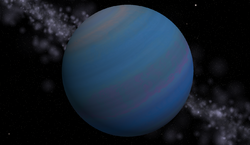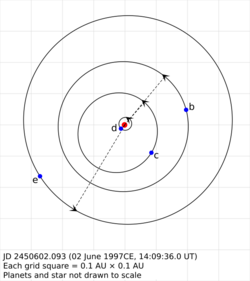Astronomy:Gliese 876 e
 An artist's impression of Gliese 876 e | |
| Discovery[1] | |
|---|---|
| Discovered by | Rivera et al. |
| Discovery date | June 23, 2010 |
| Doppler spectroscopy | |
| Orbital characteristics[2][3] | |
| Epoch BJD 2,450,602.09311 | |
| 0.3355+0.0019 −0.0011 astronomical unit|AU | |
| Eccentricity | 0.0545+0.0069 −0.022 |
| Orbital period | 123.55+1.0 −0.59 d |
| Mean anomaly | 50.3°+46° −86.8° |
| Inclination | 56.7°+1.0° −0.99° |
| 240°+23° −50° | |
| Semi-amplitude | 3.49±0.23 m/s |
| Star | Gliese 876 |
| Physical characteristics[3] | |
| Mass | 16.0±1.0 M⊕ |
Gliese 876 e is an exoplanet orbiting the star Gliese 876 in the constellation of Aquarius. It is in a 1:2:4 Laplace resonance with the planets Gliese 876 c and Gliese 876 b: for each orbit of planet e, planet b completes two orbits and planet c completes four. This configuration is the second known example of a Laplace resonance after Jupiter's moons Io, Europa and Ganymede.[1] Its orbit takes 124 days to complete.
Gliese 876 e has a mass similar to that of the planet Uranus. Its orbit takes 124 days to complete, or roughly one third of a year. While the orbital period is longer than that of Mercury around the Sun, the lower mass of the host star relative to the Sun means the planet's orbit has a slightly smaller semimajor axis. Unlike Mercury, Gliese 876 e has a nearly circular orbit with an eccentricity of 0.055 ± 0.012.[1]
This planet, like b and c, has likely migrated inward.[4]
References
- ↑ 1.0 1.1 1.2 Rivera, Eugenio J. et al. (July 2010). "The Lick-Carnegie Exoplanet Survey: A Uranus-mass Fourth Planet for GJ 876 in an Extrasolar Laplace Configuration". The Astrophysical Journal 719 (1): 890–899. doi:10.1088/0004-637X/719/1/890. Bibcode: 2010ApJ...719..890R.
- ↑ Millholland, Sarah et al. (2018). "New Constraints on Gliese 876—Exemplar of Mean-motion Resonance". The Astronomical Journal 155 (3). doi:10.3847/1538-3881/aaa894. Bibcode: 2018AJ....155..106M.
- ↑ 3.0 3.1 Moutou, C. et al. (July 2023). "Characterizing planetary systems with SPIRou: M-dwarf planet-search survey and the multiplanet systems GJ 876 and GJ 1148". Astronomy & Astrophysics.
- ↑ Gerlach, Enrico; Haghighipour, Nader (2012). "Can GJ 876 host four planets in resonance?". Celestial Mechanics and Dynamical Astronomy 113 (1): 35–47. doi:10.1007/s10569-012-9408-0. Bibcode: 2012CeMDA.113...35G.
 |


